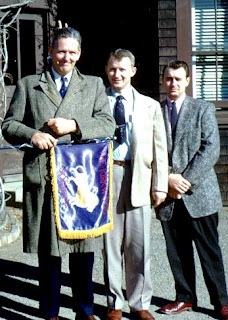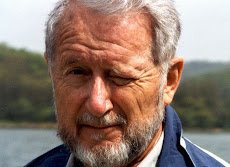KIRKWOOD OBSERVATORY
Near the southwest edge of the Indiana University (IU) campus, this observatory building was the center of most of the on-campus activities for astronomy graduate students. In it is a 0.3 meter (12 inch) refracting telescope, and on public nights there were a good many visitors.
Graduate students occupied the rooms on the south wing, and my desk was immediately inside the southeast corner, shown here in sunshine.
 The Observatory was named after Professor Daniel Kirkwood, and the gaps in Saturn’s rings are named after him. Thus it was impossible to avoid the expression “Home of the Kirkwood Gaps” when explaining where we worked. We chose the name “Observatory Fantastique” as more nearly representative, however. We then organized ourselves into The Kirkwood Society. Each graduate student became the president of a subsidiary group, and we had our own stationary printed to use when communicating with the outside world.
The Observatory was named after Professor Daniel Kirkwood, and the gaps in Saturn’s rings are named after him. Thus it was impossible to avoid the expression “Home of the Kirkwood Gaps” when explaining where we worked. We chose the name “Observatory Fantastique” as more nearly representative, however. We then organized ourselves into The Kirkwood Society. Each graduate student became the president of a subsidiary group, and we had our own stationary printed to use when communicating with the outside world. Our stationary permitted us to have some contact with the outside world, and those who had letters from us never failed to respond. This page makes clear how some of our time was used in novel ways.
Our stationary permitted us to have some contact with the outside world, and those who had letters from us never failed to respond. This page makes clear how some of our time was used in novel ways.On the left one can see a list of our societies. They are, in descending order, the Kirkwood Bachelor Association, the president of which was always in dispute. The Kirkwood Kodachrome and Kopi Klimbing Klub derived from Art Cox’s trip to South Africa, where he climbed Kopis. The Kirkwood Primitive Dance and Drum Beating Society met for Indiana University Football and Basketball games. The Kirkwood Bird Watchers Society was incredibly esoteric. Charles L. Perry, the President of the Beard Raisers Club, kept practicing different beards for the president’s picture. Ray Grenchik, the owner of the Observatory’s principal protector, his dog Torreon, headed up the Kirkwood Society for the Protection and Care of Torreon and Undergraduates. Mary Connelly occasionally appeared on television—a very new thing in those days, and she was destined to head up the Kirkwood Television Guild. To belong, you had to appear at some time or another on TV. Arnie Heiser managed he Kirkwood Stone Lion and Idlers Association, an enviable assignment, and we all planned to one day have stone lions at the Observatory entrance. Tom Bartlett, a senior student from Denver University, was always concerned about our being overworked, and thus was a natural for the Kirkwood Anti-Slavery League. Our machinist, Marion Todd, was always assumed by the university to be a female, and we were ever answering the phone for a Miss Todd. He thus became the head of the Kirkwood Foundation for Lady Machinists.
The mantel of the fireplace was the site of the Kirkwood Museum, and Phil Barnhart kept order there. John Cox, our regular cigar smoker, became the keeper of the Kirkwood Fumatorium, and Arnold Klemola became our librarian, for wherever he was, his head was in a book. As time passed, presidents could change. The stationary, however, did not.
Addie Leah made a flag for us of blue satin, and she embroidered on it the constellation of Leo in yellow silk. The fringe came from a local funeral home, and was a donation. We took it to astronomical meetings, and to distant parts of the world as opportunities arose. Arlo Landolt carried the flag to the South Pole where he worked for a year.


At the Cannadian Border

At the High Altitude Observatory, Colorado
Here is a picture of Arlo Landolt just before he left for the South Pole. The flag was with him there for a year!  And this picture shows us, but we're not quite sure just where!
And this picture shows us, but we're not quite sure just where!

 The Society with faculty at Boulder, Colorado
The Society with faculty at Boulder, ColoradoProf. and Mrs. Edmondson, Prof. Irwin, R. Brownlee, Arnold Klemola, J. P. Mutschlecner, Art Cox, Charles Perry, Tom Bartlett, Ray Grenchik, and Prof. James Cuffey.
 By a camp fire in Colorado: Nancy Brownlee, Charles Perry, Wayne Brownlee, Jeanne Brownlee, and R.R. Brownlee. Notice that here we see a pennant on the Kirkwood flag pole. Those were added for places of unusual achievements.
By a camp fire in Colorado: Nancy Brownlee, Charles Perry, Wayne Brownlee, Jeanne Brownlee, and R.R. Brownlee. Notice that here we see a pennant on the Kirkwood flag pole. Those were added for places of unusual achievements.



Even Stone Lions notice when the flag passes by.
The flag is now in the home of the seamstress, though its color has changed rather dramatically in 50 years.

In 2007 it made a trip to Antarctica once again. Our family flag, together with pennants appears in many pictures of our family outings. On the Antarctica trip, the flag flew just below the family flag.
 There was much more to the Kirkwood Society than stationary and flags. We gave a faculty roast each year, collected artifacts for the museum and added just enough good humor to make make life not just tolerable, but delightful. Not all faculty members were equally pleased, and that added to our delight.
There was much more to the Kirkwood Society than stationary and flags. We gave a faculty roast each year, collected artifacts for the museum and added just enough good humor to make make life not just tolerable, but delightful. Not all faculty members were equally pleased, and that added to our delight.
It would be quite improper to close these remarks about Kirkwood Observatory without printing a picture of a big campus event in 1916 (from the Indiana University Archive). It was commemorating the Greeks in some fashion or other. But the picture includes a covered wagon, and we were very pleased to see that. The observatory dome is completely washed out in the picture. Never mind. You know how domes are shaped.
We also noted that there is someone looking out of the Observatory Window. It was only natural that we would look at that person closely. A picture in our files taken at Yerkes Observatory gave us just the clue we needed.

Wayne, Nancy, Jeanne, Addie Leah Paul Mutschlecner, Charles Perry, Bob Brownlee


Prof. Irwin, RRB, and Charles Perry. RRB and the flag on Long's Peak
John Irwin was my Thesis Advisor.


To the left, Goethe Link Observatory is shown. To the right are Professor Frank K and Mrs. Margaret Edmondson. Prof. Edmondson, better known to all of us as FKE, was probably the inspiration for the Kirkwood Beard Raisers Club. He inspired many activities, including travel.

Torreon, Ray Grenchik's dog, was a campus fixture. Occasionally he could be found at the Student Union, embarassing us all. Here is a picture taken upon one of his returns to Kirkwood Obwervatory with a trophy.

Finally, we must add a picture of the Cooke Telescope. It was our instrument for observing and documenting Asteroids, and provided a number of students with work and funding.





1 comment:
These stories are really great! Some of them I don't recall hearing, those I have heard before are just as delightful when heard again. Love the pictures!
Post a Comment